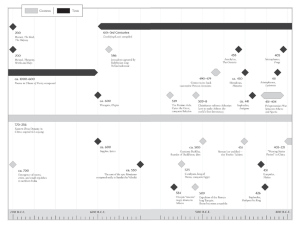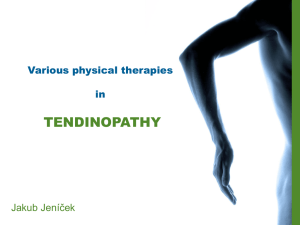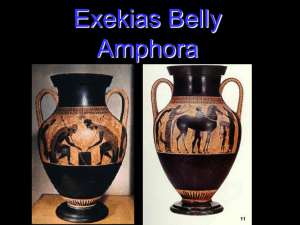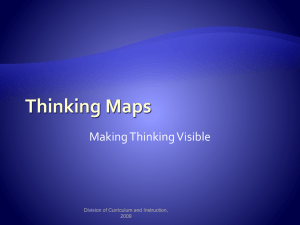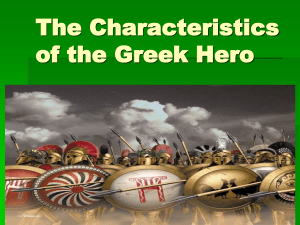Fashler_Danielle_RSPT_572_Systematic_Review_Topics
advertisement
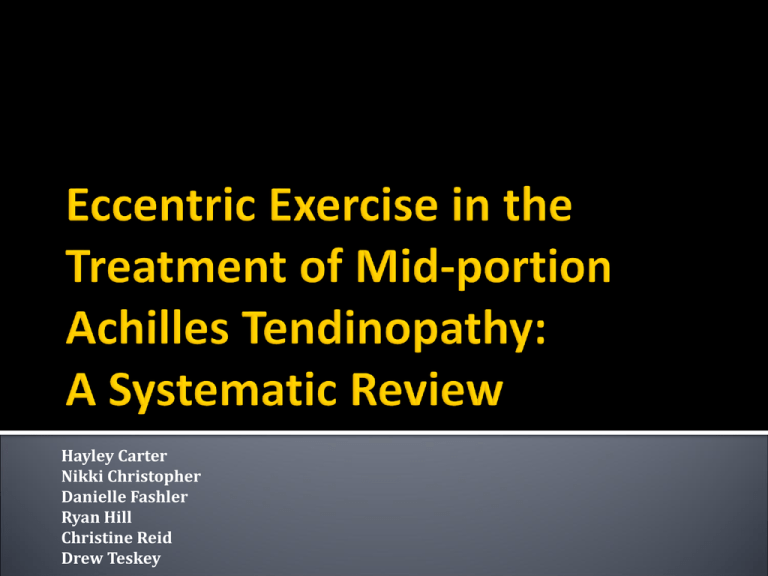
Hayley Carter Nikki Christopher Danielle Fashler Ryan Hill Christine Reid Drew Teskey Introduction Methods Results Discussion Conclusion Background Information and Research Questions Chronic pain in the Achilles tendon Aggravated with loading activities Tenderness on palpation Often “thickening” of the tendon ↓ participation in sport, ADLs Achilles Tendonitis • Inflammation of the Achilles tendon (misnomer) Achilles Tendinosis • Damage at the cellular level (histological term) Up to 18% of all injuries seen in runners 9% of elite runners are affected Not JUST athletes... 31% of AT study participants are “Sports injury?” sedentary Interaction between intrinsic & extrinsic factors: INTRINSIC Overpronation hindfoot Varus forefoot Quads and Gastroc weakness Advanced age Obesity EXTRINSIC Training errors Poor movement techniques Poor footwear Running on hard/uneven surfaces Failed healing response? Neovasculature and nerve proliferation ↓ pain ↓ neovessels Scott, A., (2010) Ultrasound Shock-wave therapy Corticosteroid injections Surgery NSAIDs Eccentric Exercise Conservative approach Low-cost No equipment Self-management Effective Mechanism? • Mechanical sclerosing • Collagen remodelling Is eccentric exercise more effective than other physical therapy treatments at reducing pain in adults with chronic Achilles tendinopathy? Is eccentric exercise more effective than other physical therapy treatments at improving function and patient satisfaction in adults with chronic Achilles tendinopathy? Search Strategy, Selection Criteria and Quality Assessment Population Intervention Comparison Outcome • Adults (18-65) with chronic (≥ 3months) midportion Achilles Tendinopathy • Eccentric heel drop protocol ≥ 6wk duration • Other treatment (including no treatment) • Pain (Primary) • Function and Patient Satisfaction (Secondary) MEDLINE (1950 – Present) EMBASE (1980 – Present) CINAHL (1982 – Present) PubMed (1949 – Present) PEDro (1929 – Present) Wed of Science Grey Literature (eg. TRIP, SUMSearch, Toby) Tend* OR Tendinitis – focus (Thesaurus) Achilles OR Achilles Tendon (Thesaurus) AND Eccentric OR Eccentric Muscle Contraction – explode (Thesaurus) RCT filter = (random* AND control* AND trial*) OR (RCT*) Example: EMBASE Web of Science 32 EMBASE 16 CINAHL 17 284 Medline 25 (with duplicates) PubMed 24 PEDro 15 Other 155 1) 2) 3) 4) 5) Randomized control trial Human participants, mean age 18-65, with chronic (≥ 3 months) mid-portion AT Participants with no other past or present Achilles tendon pathology or other significant L/E pathology Experimental group underwent eccentric heel drop exercise protocol lasting ≥ 6 weeks Included outcome measures of pain, function (ROM, strength, or functional scales), patient satisfaction, or return to activity 1) 2) 3) 4) 5) 6) Not available in full text Not available in English Retrospective or non-original studies In-vitro studies Animal subjects Comparison group included an eccentric protocol Study Selection TOTAL HITS 284 First level screen • Title 21 remain Second level screen • Abstract Third level screen 11 remain • Full text INCLUDED IN REVIEW 5 total Sackett’s Level of Evidence & PEDro Scores: Study Sackett’s Level of Evidence PEDro criteria* 1 2 3 4 5 6 7 8 9 10 11 PEDro score (/11) Chester II (n=16) X X X X X 6 Herrington II (n=25) X X X X 7 Mafi II (n=44) X X X X 7 Peterson I (n=72) X X X 8 Rompe I (n=75) X X 9 PEDro criteria: 1 – Eligibility criteria 2 – Random allocation 3 – Concealed allocation 4 – Baseline comparability 5 – Subject blinding 6 – Therapist blinding 7 – Assessor blinding 8 – > 85% follow-up for at least one outcome 9 – Intention-to-treat analysis 10 – Between-group comparisons 11 – Point measures and variability reported - Criterion met X – Criterion not met or not specified Description of Review Findings Insufficient homogeneity for meta-analysis 1. Different comparators Study Comparison Group(s) Chester et al. (2007) Ultrasound Herrington & McCulloch (2007) Standard Care (ultrasound, deep friction massage and stretching) Mafi et al. (2000) Concentric Exercise Petersen et al. (2007) AirHeel Brace Rompe et al. (2007) 1) Wait-and-See 2) Shockwave Therapy Results 2. Different outcome measures Pain ▪ (VAS, VISA-A, Load-induced pain, Pain threshold, TOP) Function ▪ (FILLA, AOFAS, VISA-A) Patient Satisfaction ▪ (EuroQol, SF-36, Likert scale, “Yes/No”) Comparison Outcome Measure Eccentrics better? EE vs. Ultrasound VAS* No EE vs. AirHeel Brace VAS Yes (rest; P<0.001) No*** (walking) No (sport) EE vs. Concentric Exercise VAS Yes EE vs. Shockwave Author designed** No EE vs. Wait and See Author designed Yes (P<0.001) (all) (walking; P<0.001) *VAS scores at rest, during walking, and/or during sport. **Load-induced pain, pain threshold, and tenderness on palpation. ***Effects of AHB significantly greater than EE Comparison Outcome Measure Eccentrics Better? EE vs. Ultrasound FILLA No EE vs. AirHeel Brace AOFAS No EE vs. Shockwave Therapy VISA-A No EE vs. Standard Care VISA-A Yes (P = 0.014) EE vs. Wait-and-See VISA-A Yes (P < 0.001) Comparison Outcome Measure Eccentrics Better? EE vs. Ultrasound EuroQol No EE vs. AirHeel Brace SF-36 Return to Sport No No EE vs. Shockwave Therapy Likert Scale No EE vs. Concentric Exercise Return to Sport Yes (P = 0.002) EE vs. Wait-and-See Likert Scale Yes (P < 0.001) PAIN FUNCTION SATISFACTION Comparison Outcome Measure Eccentrics better? EE vs. Ultrasound VAS* No (all) EE vs. AirHeel Brace VAS Yes (rest; P<0.001) No# (walking) No (sport) EE vs. Concentric Exercise VAS Yes (walking; P<0.001) EE vs. Shockwave Author designed** No EE vs. Wait and See Author designed Yes (P<0.001) Comparison Outcome Measure Eccentrics Better? EE vs. Ultrasound FILLA No EE vs. AirHeel Brace AOFAS No EE vs. Shockwave Therapy VISA-A No EE vs. Standard Care VISA-A Yes (P = 0.014) EE vs. Wait-and-See VISA-A Yes (P < 0.001) Comparison Outcome Measure Eccentrics Better? EE vs. Ultrasound EuroQol No EE vs. AirHeel Brace SF-36 Return to Sport No No EE vs. Shockwave Therapy Likert Scale No EE vs. Concentric Exercise Return to Sport Yes (P = 0.002) EE vs. Wait-and-See Likert Scale Yes (P < 0.001) PAIN FUNCTION SATISFACTION Comparison Outcome Measure Eccentrics better? EE vs. Ultrasound VAS* No (all) EE vs. AirHeel Brace VAS Yes (rest; P<0.001) No# (walking) No (sport) EE vs. Concentric Exercise VAS Yes (walking; P<0.001) EE vs. Shockwave Author designed** No EE vs. Wait and See Author designed Yes (P<0.001) Comparison Outcome Measure Eccentrics Better? EE vs. Ultrasound FILLA No EE vs. AirHeel Brace AOFAS No EE vs. Shockwave Therapy VISA-A No EE vs. Standard Care VISA-A Yes (P = 0.014) EE vs. Wait-and-See VISA-A Yes (P < 0.001) Comparison Outcome Measure Eccentrics Better? EE vs. Ultrasound EuroQol No EE vs. AirHeel Brace SF-36 Return to Sport No No EE vs. Shockwave Therapy Likert Scale No EE vs. Concentric Exercise Return to Sport Yes (P = 0.002) EE vs. Wait-and-See Likert Scale Yes (P < 0.001) PAIN FUNCTION SATISFACTION Comparison Outcome Measure Eccentrics better? EE vs. Ultrasound VAS* No (all) EE vs. AirHeel Brace VAS Yes (rest; P<0.001) No# (walking) No (sport) EE vs. Concentric Exercise VAS Yes (walking; P<0.001) EE vs. Shockwave Author designed** No EE vs. Wait and See Author designed Yes (P<0.001) Comparison Outcome Measure Eccentrics Better? EE vs. Ultrasound FILLA No EE vs. AirHeel Brace AOFAS No EE vs. Shockwave Therapy VISA-A No EE vs. Standard Care VISA-A Yes (P = 0.014) EE vs. Wait-and-See VISA-A Yes (P < 0.001) Comparison Outcome Measure Eccentrics Better? EE vs. Ultrasound EuroQol No EE vs. AirHeel Brace SF-36 Return to Sport No No EE vs. Shockwave Therapy Likert Scale No EE vs. Concentric Exercise Return to Sport Yes (P = 0.002) EE vs. Wait-and-See Likert Scale Yes (P < 0.001) PAIN FUNCTION SATISFACTION Comparison Outcome Measure Eccentrics better? EE vs. Ultrasound VAS* No (all) EE vs. AirHeel Brace VAS Yes (rest; P<0.001) No# (walking) No (sport) EE vs. Concentric Exercise VAS Yes (walking; P<0.001) EE vs. Shockwave Author designed** No EE vs. Wait and See Author designed Yes (P<0.001) Comparison Outcome Measure Eccentrics Better? EE vs. Ultrasound FILLA No EE vs. AirHeel Brace AOFAS No EE vs. Shockwave Therapy VISA-A No EE vs. Standard Care VISA-A Yes (P = 0.014) EE vs. Wait-and-See VISA-A Yes (P < 0.001) Comparison Outcome Measure Eccentrics Better? EE vs. Ultrasound EuroQol No EE vs. AirHeel Brace SF-36 Return to Sport No No EE vs. Shockwave Therapy Likert Scale No EE vs. Concentric Exercise Return to Sport Yes (P = 0.002) EE vs. Wait-and-See Likert Scale Yes (P < 0.001) Explanation of the Results, Study Limitations and Implications for Research & Clinicians Variability of results makes it difficult to draw firm conclusions Contributing Factors: 1. Study quality 2. Study sample characteristics 3. Intervention parameters 4. Selection of outcome measures. PEDro Scores Subject & therapist blinding Assessor blinding Conflict of Interest? PEDro Scores: Study Sackett’s Level of Evidence PEDro criteria* 1 2 3 4 5 6 7 8 9 10 11 PEDro score (/11) Chester II (n=16) X X X X X 6 Herrington II (n=25) X X X X 7 Mafi II (n=44) X X X X 7 Peterson I (n=72) X X X 8 Rompe I (n=75) X X 9 PEDro criteria: 1 – Eligibility criteria 2 – Random allocation 3 – Concealed allocation 4 – Baseline comparability 5 – Subject blinding 6 – Therapist blinding 7 – Assessor blinding 8 – > 85% follow-up for at least one outcome 9 – Intention-to-treat analysis 10 – Between-group comparisons 11 – Point measures and variability reported - Criterion met X – Criterion not met or not specified Chester et al (2007): PEDro score = 6/11 Pilot study Difference at baseline. ▪ ▪ ▪ ▪ ▪ ▪ ▪ Average age Average duration of symptoms Male to female ratio Greater mean functional impairment Lower incidence of existing pathologies Lower mean resting pain VAS scores Higher pain reported after sport Average age No relationship Previous fitness level of participants Apparent positive correlation between the previous fitness level and effectiveness of EE Early studies on recreational athletes. EE protocols require patients to push through pain to complete multiple repetitions of exercises Patients with previous experience with exercise may… Be more likely to adhere to an exercise program Have better body awareness Have a more positive attitude toward exercise Have superior exercise form and body mechanics Have increased experience pushing through pain and fatigue Previously sedentary participants with no history of physical activity may… Have to make a substantial lifestyle adjustment Have some difficulty with skill acquisition of the exercises Have some difficulty with adherence to an exercise program Variability between EE protocols 90 repetitions/day (Chester et al., 2007) 180 reps/day (Herrington & McCulloch, 2007; Mafi et al., 2000; Rompe et al., 2007) 270 repetitions/day (Petersen et al., 2007) Comparability of EE and comparison interventions Unable to compare most intensities (e.g. EE vs. US) Mafi et al. (2000); EE vs. CE 4. Outcome Measures Lowest Quality Highest Quality VAS Load-induced pain Pain threshold Tenderness on palpation Pain Function FILLA Patient Satisfaction “Yes/No” Questionnaires AOFAS EuroQol VISA-A SF-36 Specific Likert Scales Lack of high quality studies • Larger sample size • Blinding of assessors • Include 3, 6, 12 month follow-ups of participants Lack of follow-up • Use standardized outcome measures, with high Lack of sensitivity and specificity (Eg. VISA-A, Likert) comparable outcome measures • Include measure of participant compliance Unclear exercise parameters • Identify optimal dosage (set, reps, intensity, pain) • Identify optimal duration of training Lack comparable, Level I data: • • • • Lack reproducible results Lack quality, generalizability Lack specific exercise parameters Unclear patient demographics Support for eccentric exercise: • • • • At least as effective as other Rx Safe, low-cost, non-invasive option Some patients may respond more favourably May be minimal dose below which there may be limited to no effect Implications for Clinicians Not a stand-alone treatment! Remember… INTRINSIC Overpronation hindfoot Varus forefoot Quads and Gastroc weakness Advanced age Obesity EXTRINSIC Training errors Poor movement techniques Poor footwear Running on hard/uneven surfaces Take home message EE is at least as effective as other treatments Trends: • Patient population: Athletic >> sedentary • Exercise intensity: higher >> lower Eccentric Exercise is a safe and effective treatment option for adults with chronic Achilles tendinopathy. It should be used alongside other physiotherapy interventions to ensure a holistic approach to care. Special thank you to: Dr. Teresa Liu-Ambrose Other contributors: Dr. Alex Scott Dr. Elizabeth Dean Dr. Darlene Reid Charlotte Beck Dean Giustini Abbassian, A. and Khan, R., (2009). Achilles tendinopathy: pathology and management strategies. Br J Hosp Med, 70(9), 519-523. Alfredson, H., Pietilä, T., Jonsson, P., & Lorentzon, R. (1998). Heavy-load eccentric calf muscle training for the treatment of chronic Achilles tendinosis. Am J Sports Med, 26, 360 Alfredson, H. (2005). The chronic painful Achilles and patellar tendon: Research on basic biology and treatment. Scand J Med Sci Sports, 15, 252–259. Brazier, J. E., Jones, N. M., Kind, P. (1993). Testing the validity of the EuroQol and comparing it with the SF-36 health survey questionnaire. Quality of Life Research, 2(3), 169-180. Brooks, R. (1996). EuroQol: the current state of play. Health Policy, 37, 53–72. Chester, R., Costa, M.L., Cooper, A. & Donell, S.T. (2007). Eccentric calf muscle training compared with therapeutic ultrasound for chronic Achilles tendon pain – A pilot study. Manual Therapy. 13, 484-91. Herrington, L. & McCulloch, R. (2007). The role of eccentric training in the management of Achilles tendinopathy: A pilot study. Physical Therapy in Sport. 8, 191-6. Langberg, H., Ellingsgaard, H., Madsen, T. Jansson, J., Magnusson, S.P., Aagaard, P., & Kjær, M. (2007). Eccentric rehabilitation exercise increases peritendinous type I collagen synthesis in humans with Achilles tendinosis. Sacd J Med Sci Sports, 17, 61-6. Mafi, N., Lorentzon, R. & Alfredson, H. (2001). Superior short-term results with eccentric calf muscle training compared to concentric training in a randomized prospective multicenter study on patients with chronic Achilles tendinosis. Journal of Knee Surgery, Sports Traumatology and Arthroscopy. 9, 42-7. Magnussen, R. A., Dunn, W. R., & Thompson, B. (2009). Nonoperative treatment of midportion Achilles tendinopathy: A systematic review. Clin J Sport Med, 19(1), 54-64. Nørregaard, J., Larsen, C. C., Bieler, T., & Langberg, H. (2007). Eccentric exercise in treatment of Achilles tendinopathy. Scand J Med Sci Sports, 17, 133-8. Paavola, M., Orava, S., Leppilahti, J., Kannus, P., & Järvinen, M., (2000). Chronic Achilles tendon overuse injury: Complications after surgical treatment. An analysis of 432 consecutive patients. Am J Sports Med, 28, 77–82. Petersen, W., Welp, R. & Rosenbaum, D. (2007). Chronic Achilles tendinopathy: A prospective randomized control study comparing the therapeutic benefit of eccentric training, the AirHeel Brace, and a combination of both. The American Journal of Sports Medicine. 35(10), 1659-66. Rees, J., Wilson, A., & Wolman, R. (2006). Current concepts in the management of tendon disorders. Oxford University Press, 45, 508-521. Rees, J. D., Lichtwark, G. A., Wolman, R. L., & Wilson, A. M. (2008). The mechanism for efficacy of eccentric loading in Achilles tendon injury; an in vivo study in humans. Rheumatology, 47, 1493-7. Robinson, J. M., Cook, J. L., Purdam, C., Visentini, P. J., Ross, J., Maffulli, et al. et al. (2001). The VISA-A questionnaire: a valid and reliable index of the clinical severity of Achilles tendinopathy. British Journal of Sports Medicine, 35, 335-341. Rompe, J.D., Nafe, B., Furia, J.P. & Maffulli, N. (2007). Eccentric loading, shock-wave treatment, or a wait-and-see policy for tendinopathy of the main body of Tendo Achillis: A randomized control trial. The American Journal of Sports Medicine.35(3), 374-83. Rompe, J. D., Furia, J. P., & Maffulli, N. (2008). Mid-portion achilles tendinopathy - current options for treatment. Disability & Rehabilitation, 30(20), 1666-76. Scott, A. (2010). Tendinopathies: Beyond the Achilles [PowerPoint slides]. Retrieved from http://www.bcphysio.org/app/index.cfm?fuseaction=membercourse.download Silbernagel, K. G., Thomee, R., Thomee, P., & Karlsson, J. (2001). Eccentric overload training for patients with chronic Achilles tendon pain – a randomized controlled study with reliability testing of the evaluation methods. Scan J Med Sci Sports, 11, 197-206. Süleyman, H., Demircan, B., & Karagöz, Y. (2007). Anti-inflammatory and side effects of cyclooxygenase inhibitors. Pharmacological Reports, 59, 247-258. Tan, S. C., & Chan, O. (2008). Achilles and patellar tendinopathy: Current understanding of pathophysiology and management. Disability & Rehabilitation, 30(20), 1608-15. Tsai, W., Hsu, C., Chou, S., Chung, C., & Chen, J. (2007). Effects of celecoxib on migration, proliferation and collagen expression of tendon cells. Connect Tissue Res, 48(1), 46-51. Verhagen, A., de Vet, H., de Bie, R., Kessels, A., Boers, M., Bouter L., & Knipschild, P. (1998). The delphi list: a criteria list for quality assessment of randomized clinical trials for conducting systematic reviews developed by delphi consensus. Journal of Clinical Epidemiology, 51, 1235–1241. Woodley, B.L., Newsham-West, R.J., & Baxter, G.D. (2007). Chronic tendinopathy: Effectiveness of eccentric exercise. Br J Sports Med, 41, 188-199. Questions?

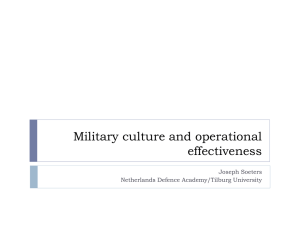
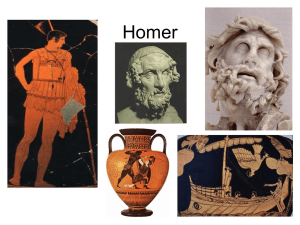
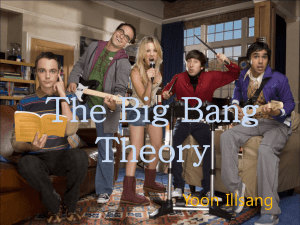
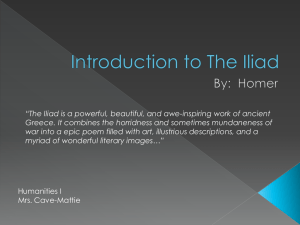
![Jiye Jin-2014[1].3.17](http://s2.studylib.net/store/data/005485437_1-38483f116d2f44a767f9ba4fa894c894-300x300.png)
